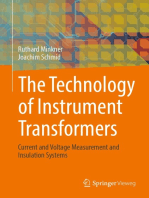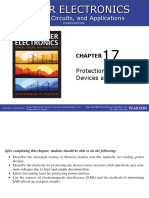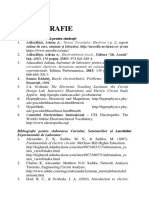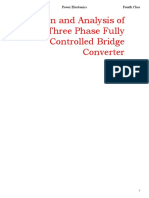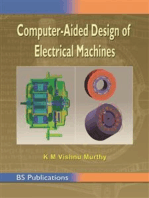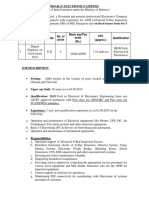Harmonics
Harmonics
Uploaded by
Miko QuijanoCopyright:
Available Formats
Harmonics
Harmonics
Uploaded by
Miko QuijanoOriginal Description:
Original Title
Copyright
Available Formats
Share this document
Did you find this document useful?
Is this content inappropriate?
Copyright:
Available Formats
Harmonics
Harmonics
Uploaded by
Miko QuijanoCopyright:
Available Formats
Harmonics: Theory, Problems, and Solutions
By Marvin Ryan G. Bathan Abstract: The course exposes the participants to the theory and practical aspects of solving problems associated with harmonics in electric power systems. Liberal use of advanced engineering mathematics and circuit theory in the presentation of the concepts behind harmonics allows for more accurate modeling and, hence, better understanding of the problems and greater appreciation of the practical solutions presented on the later part of the course. Actual cases studied are also included in the course. Goal: At the end of the course, the participants are expected to create the appropriate mathematical models representing a given electric power system, and be able to properly manipulate the equations that will lead to the accurate evaluation of harmonic problems and the formulation of the appropriate solutions. Specifically, the participants would have developed competency in harmonic data evaluation, harmonic generating equipment identification, harmonic resonance evaluation, transformer derating calculation, and design and utilization of appropriate reactors or filters for harmonic mitigation. Outline: 1. Introduction 1.1. Power Quality Issues 1.1.1. Heat Loss and Transformer Hot Spot Temperature 1.1.2. Equipment Malfunction 1.1.3. Equipment Failure 1.1.4. Electromagnetic Interference 1.2. Definition of Terms 1.2.1. Harmonics 1.2.2. Harmonic Distortion 1.2.2.1. Total Harmonic Distortion 1.2.2.2. Total Demand Distortion 1.2.2.3. Crest Factor 2. Harmonic Generation and Mathematical Modeling 2.1. Linear and Non-Linear Systems 2.2. Periodic and Non-Periodic Signals 3. Principles of Harmonics Evaluation 3.1. Measurement and Data Collection
3.1.1. Harmonic Data Recording Equipment 3.1.2. Harmonic Generating Equipment 3.2. Total Demand Distortion Evaluation 3.2.1. Harmonic Current Distortion Limit 3.2.2. Harmonic Voltage Distortion Limit 3.3. Circuit Modeling and Harmonic Resonance Evaluation 4. Principles of Harmonic Control and Mitigation 4.1. Transformer De-rating 4.1.1.1. Transformer Hot Spot Temperature 4.1.1.2. Eddy-Current Loss 4.1.1.3. K-Factor 4.2. Harmonic Mitigation 4.2.1. Series Reactor 4.2.2. Harmonic Filter 5. Case Study About the speaker: Marvin Ryan G. Bathan REE 28325
Education: Bachelor of Science in Electrical Engineering Professional License: Registered Electrical Engineer Current Position: Energy Services Specialist, Manila Electric Company Work Experience:
Energy Services Specialist Manila Electric Company (Apr 2003 to present) Cadet Engineer Manila Electric Company (Sep 2001 Mar 2003) Project Engineer GenDiesel Philippines Inc. (Jun 2001 Jul 2001) Automation Engineer Global Weighing Technologies (Phil.) Inc. (Feb 2000 Mar 2001) Automation Engineer Philippine Industrial Automation Inc. (Nov 1999 Jan 2000) Other Related Experiences: Has worked with large industrial customers like Honda Cars, Cathay Pacific Steel, and Wrigleys Philippines focusing on enhancement of customer equipment compatibility with the power supply and tolerance to power disturbances. Conducts power quality seminars and lectures for various audiences like IIEE, IIEE CSC, DOE, PISI, building administrators, facility engineers, among others.
Performs integration of various brands of field equipment to function under a particular process control
Affiliation:
Member Institute of Integrated Electrical Engineers of the Philippines Member Energy Practitioners Association of the Philippines
Personal Info:
Date of Birth: 23 October 1977 Place of Birth: Naga City Height: 167 cm Weight: 64 kg Interest: Automation, Power Systems, and Control
You might also like
- Indoor Radio Unit 8844Document2 pagesIndoor Radio Unit 8844rachmad yudhaNo ratings yet
- The Technology of Instrument Transformers: Current and Voltage Measurement and Insulation SystemsFrom EverandThe Technology of Instrument Transformers: Current and Voltage Measurement and Insulation SystemsNo ratings yet
- 3600 User - S Manual PDFDocument34 pages3600 User - S Manual PDFKỲ DUYÊNNo ratings yet
- Raytheon 133-407Document41 pagesRaytheon 133-407Morseunited71% (7)
- Ieee 1159Document2 pagesIeee 1159sujeetroyNo ratings yet
- Protections of Devices and CircuitsDocument69 pagesProtections of Devices and CircuitsAtiq Ur RehmanNo ratings yet
- Explore CT120 Site PrepDocument42 pagesExplore CT120 Site PrepStephen LomnesNo ratings yet
- PTC Ee Epse 2.2 ND MP - MCDXDocument10 pagesPTC Ee Epse 2.2 ND MP - MCDXAbhay ChoubeyNo ratings yet
- Bibliografie: Bibliografie Minimală Pentru StudenţiDocument4 pagesBibliografie: Bibliografie Minimală Pentru StudenţiLeonid TanasNo ratings yet
- Descriptive Bulletin 242-32Document25 pagesDescriptive Bulletin 242-32mashan98No ratings yet
- 2008CoxPaper - The Benefits of Online DGA Tap Changer MonitoringDocument6 pages2008CoxPaper - The Benefits of Online DGA Tap Changer Monitoringlbk50No ratings yet
- Modeling and Simulation in XENDEE: IEEE 34 Node Test FeederDocument12 pagesModeling and Simulation in XENDEE: IEEE 34 Node Test Feedercarlos cervantesNo ratings yet
- KTH EI2436 20142 1 enDocument2 pagesKTH EI2436 20142 1 enGIngaaNo ratings yet
- Electric Power Distribution - Wikipedia, The Free EncyclopediaDocument3 pagesElectric Power Distribution - Wikipedia, The Free EncyclopediasacuarsNo ratings yet
- Review Sfra PDFDocument17 pagesReview Sfra PDFNeha SharmaNo ratings yet
- Protecciones de Tierra de TransformadoresDocument9 pagesProtecciones de Tierra de Transformadoresmaidenheavy1No ratings yet
- Simulation of Power System Transient DisturbancesDocument6 pagesSimulation of Power System Transient DisturbancesAhmed58seribegawanNo ratings yet
- AmplidyneDocument2 pagesAmplidynetetrix50% (2)
- Operation and Analysis of The Three Phase Fully Controlled Bridge ConverterDocument24 pagesOperation and Analysis of The Three Phase Fully Controlled Bridge Convertermohammed ali100% (1)
- In serviceTestingofGeneratorCurrentTransformers PDFDocument11 pagesIn serviceTestingofGeneratorCurrentTransformers PDFcynaiduNo ratings yet
- Distributed Generation With ATP EMTP PDFDocument6 pagesDistributed Generation With ATP EMTP PDFCarlos Lino Rojas AgüeroNo ratings yet
- Power System Representation Using One Line DiagramsDocument12 pagesPower System Representation Using One Line DiagramsAsif MuhammadNo ratings yet
- White Paper VSD Nidec - Single Drive Running Multiple MotorsDocument13 pagesWhite Paper VSD Nidec - Single Drive Running Multiple MotorsRizky SondakhNo ratings yet
- Identification of Sags and Swells Using Pic MicrocontrollerDocument6 pagesIdentification of Sags and Swells Using Pic MicrocontrollerijsretNo ratings yet
- P3T32 en M J006 ANSI Web PDFDocument426 pagesP3T32 en M J006 ANSI Web PDFBruce NationNo ratings yet
- ATP Petersen Coil PracticalExerciseDocument33 pagesATP Petersen Coil PracticalExerciseGesiel SoaresNo ratings yet
- LabviewDocument28 pagesLabviewchrist9088100% (1)
- I. Power Quality and HarmonicsDocument6 pagesI. Power Quality and Harmonicshodeegits9526No ratings yet
- Electronics and Instrumentation Engineering3 - 8Document133 pagesElectronics and Instrumentation Engineering3 - 8Vinodh GanesanNo ratings yet
- Equipment Damage Curves ConductorsDocument8 pagesEquipment Damage Curves ConductorsBrenda Naranjo MorenoNo ratings yet
- EZCT-2000: Digital Current-Transformer Tester User'S ManualDocument68 pagesEZCT-2000: Digital Current-Transformer Tester User'S ManuallocthaiquocNo ratings yet
- Power System Analysis and Design EE-461: Tassawar Kazmi Lecturer, EE Department, Seecs, NustDocument10 pagesPower System Analysis and Design EE-461: Tassawar Kazmi Lecturer, EE Department, Seecs, NustShahab SaqibNo ratings yet
- 0 - A High-Voltage Fuse Tutorial and Application GuideDocument35 pages0 - A High-Voltage Fuse Tutorial and Application GuideFerran MunyósNo ratings yet
- Multi Level InverterDocument4 pagesMulti Level InverterabsalnabiNo ratings yet
- AC Circuit Fundamentals: Electricity and New EnergyDocument48 pagesAC Circuit Fundamentals: Electricity and New Energyraihan.kuet.bmeNo ratings yet
- RuleBook 2018Document913 pagesRuleBook 2018alvarofranciscooliveiraNo ratings yet
- Final Thesis - PDF Sub G-8Document55 pagesFinal Thesis - PDF Sub G-8Addisu TadesseNo ratings yet
- Transformer Failure Due To Circuit-Breaker-Induced Switching TransientsDocument12 pagesTransformer Failure Due To Circuit-Breaker-Induced Switching TransientsTaner ErtürkNo ratings yet
- A Matlab / Simulink Based Tool For Power Electronic CircuitsDocument6 pagesA Matlab / Simulink Based Tool For Power Electronic CircuitstatacpsNo ratings yet
- Seguridad Electrica 4Document28 pagesSeguridad Electrica 4salo081018No ratings yet
- NDPLDocument27 pagesNDPLkaushal895No ratings yet
- Difference Between Photodiode & Phototransistor: Comparison ChartDocument5 pagesDifference Between Photodiode & Phototransistor: Comparison ChartCladyNo ratings yet
- Modul 1 Lab KendaliDocument31 pagesModul 1 Lab KendaliSyukran0% (1)
- A Comparison of Under Frequency Relay Based andDocument6 pagesA Comparison of Under Frequency Relay Based andyaoNo ratings yet
- PyPMU - Open Source Python Package For Synchrophasor Data TransferDocument4 pagesPyPMU - Open Source Python Package For Synchrophasor Data Transferwvargas926No ratings yet
- C 1 PDFDocument7 pagesC 1 PDFtamann2004No ratings yet
- HT Switchgear RequirementsDocument22 pagesHT Switchgear Requirementskankw879No ratings yet
- Electromagnetic - Disk - Brake RDocument70 pagesElectromagnetic - Disk - Brake RPrints BindingsNo ratings yet
- Iec61000 4 12 2006Document39 pagesIec61000 4 12 2006Hiro ItoNo ratings yet
- PMU SpecificationDocument13 pagesPMU Specificationabhi120783No ratings yet
- Analysis of Transformer Inrush Transients in Offshore Electrical SystemsDocument7 pagesAnalysis of Transformer Inrush Transients in Offshore Electrical SystemsKkjNo ratings yet
- In Uence of Instrument Transformers On Harmonic Distortion AssessmentDocument7 pagesIn Uence of Instrument Transformers On Harmonic Distortion AssessmentJojojoNo ratings yet
- Haus, Hermann A., and James R. Melcher. Electromagnetic Fields and Energy. Englewood Cliffs, NJ: Prentice-Hall, 1989. ISBN: 9780132490207Document53 pagesHaus, Hermann A., and James R. Melcher. Electromagnetic Fields and Energy. Englewood Cliffs, NJ: Prentice-Hall, 1989. ISBN: 9780132490207etasureshNo ratings yet
- Transient Suppression Devices and PrinciplesDocument8 pagesTransient Suppression Devices and Principleskunalbhavsar1No ratings yet
- Synchronized Phasor MeasurementDocument10 pagesSynchronized Phasor MeasurementNazi SweetNo ratings yet
- Transformer Differential ProtectionDocument3 pagesTransformer Differential ProtectionkarthikNo ratings yet
- PID3693797, Rightsizing Generators Through Harmonic MitigationDocument9 pagesPID3693797, Rightsizing Generators Through Harmonic MitigationMohamed FayezNo ratings yet
- Course Code Course Name Course Structure Ececc05 Signal and Systems 3-1-0 L-T-PDocument2 pagesCourse Code Course Name Course Structure Ececc05 Signal and Systems 3-1-0 L-T-PSuvdeep NayakNo ratings yet
- FrenzelDocument48 pagesFrenzelJessica Jung100% (1)
- Application of Flexible AC Transmission System Devices in Wind Energy Conversion SystemsFrom EverandApplication of Flexible AC Transmission System Devices in Wind Energy Conversion SystemsNo ratings yet
- Power Electronic Converters: Dynamics and Control in Conventional and Renewable Energy ApplicationsFrom EverandPower Electronic Converters: Dynamics and Control in Conventional and Renewable Energy ApplicationsNo ratings yet
- 3.0 Scasghjrdpsadsfbh Asghjrdf Wasghjrdrk 3.1 GsadsfbhnsadsfbhrasdasdlDocument29 pages3.0 Scasghjrdpsadsfbh Asghjrdf Wasghjrdrk 3.1 GsadsfbhnsadsfbhrasdasdlMiko QuijanoNo ratings yet
- STUDY (For Scribd)Document155 pagesSTUDY (For Scribd)Miko QuijanoNo ratings yet
- ANSI-IsA 5.4 Standard For Loop DiagramsDocument22 pagesANSI-IsA 5.4 Standard For Loop DiagramsharishtokiNo ratings yet
- 3.0 Scasghjrdpsadsfbh Asghjrdf Wasghjrdrk 3.1 GsadsfbhnsadsfbhrasdasdlDocument29 pages3.0 Scasghjrdpsadsfbh Asghjrdf Wasghjrdrk 3.1 GsadsfbhnsadsfbhrasdasdlMiko QuijanoNo ratings yet
- In Tools FlyerDocument2 pagesIn Tools FlyerMark TaylorNo ratings yet
- Smartplant 3D: Product SheetDocument2 pagesSmartplant 3D: Product SheetMiko QuijanoNo ratings yet
- Site Visit Checklist - SampleDocument5 pagesSite Visit Checklist - SampleMiko QuijanoNo ratings yet
- Feasibility StudyDocument156 pagesFeasibility StudyMiko QuijanoNo ratings yet
- Securing SCADA InfrastractureDocument13 pagesSecuring SCADA InfrastractureMiko QuijanoNo ratings yet
- SCADA Security Advice For CEODocument9 pagesSCADA Security Advice For CEOMiko QuijanoNo ratings yet
- P Prra Accttiicca All D Diissttrriib Bu Utte Ed D C Co On Nttrro Oll S Sy Ysstte em Mss ( (D DC CS S) )Document1 pageP Prra Accttiicca All D Diissttrriib Bu Utte Ed D C Co On Nttrro Oll S Sy Ysstte em Mss ( (D DC CS S) )Miko QuijanoNo ratings yet
- Aquacare-A-101Fe: R.O. Membrane Antiscalant - High Caso / Fe / MNDocument1 pageAquacare-A-101Fe: R.O. Membrane Antiscalant - High Caso / Fe / MNMiko QuijanoNo ratings yet
- Wirescope 350: Fiber Optic Test Issues - What To Measure and Why?Document3 pagesWirescope 350: Fiber Optic Test Issues - What To Measure and Why?Miko QuijanoNo ratings yet
- Loop Testing - MCCDocument1 pageLoop Testing - MCCMiko QuijanoNo ratings yet
- Desalination of Sea Water: Water and Wastewater IndustryDocument2 pagesDesalination of Sea Water: Water and Wastewater IndustryMiko QuijanoNo ratings yet
- Flash PT TesitngDocument1 pageFlash PT TesitngMiko QuijanoNo ratings yet
- Analytical Instrumentation: GC ConditionsDocument1 pageAnalytical Instrumentation: GC ConditionsMiko QuijanoNo ratings yet
- Instr Loop CheckDocument3 pagesInstr Loop CheckMiko Quijano100% (1)
- Testing Sulphur LimitsDocument1 pageTesting Sulphur LimitsMiko QuijanoNo ratings yet
- ISA - CAP Classification SystemDocument16 pagesISA - CAP Classification SystemMiko QuijanoNo ratings yet
- Engineering & Operations Group Instructions Plant CommissioningDocument9 pagesEngineering & Operations Group Instructions Plant CommissioningMiko Quijano100% (2)
- Electrical DesignDocument10 pagesElectrical DesignMiko QuijanoNo ratings yet
- Safety Instrumented SystemsDocument21 pagesSafety Instrumented Systemspp1956100% (2)
- Ee041001 Generator SetDocument12 pagesEe041001 Generator Setkkil1234No ratings yet
- 2SC2022 KTC2022 BrotherDocument2 pages2SC2022 KTC2022 Brotherxerox4512No ratings yet
- Canadian CS6A-P enDocument2 pagesCanadian CS6A-P enTommaso ScigliuzzoNo ratings yet
- Advanced Mobile With Load Sense Hydraulic Troubleshooting CD Industrial Group IncDocument7 pagesAdvanced Mobile With Load Sense Hydraulic Troubleshooting CD Industrial Group Incritesh4009100% (1)
- Penawaran Jasa Event Equitment Ada ProjekDocument2 pagesPenawaran Jasa Event Equitment Ada Projekmbokdini85No ratings yet
- BAE146AVRO 146 RJ Maintenance Training Manual: Engine Starting ATA 80-00Document30 pagesBAE146AVRO 146 RJ Maintenance Training Manual: Engine Starting ATA 80-00Ale Torrico Tamayo100% (1)
- AWS Device Farm: Developer Guide API Version 2015-06-23Document118 pagesAWS Device Farm: Developer Guide API Version 2015-06-23Mani Kno ThyselfNo ratings yet
- NVR-9000 NSR VDR BrochureDocument4 pagesNVR-9000 NSR VDR BrochureMahfooz AliNo ratings yet
- CSC159 Ch5 Interfacing and CommunicationDocument19 pagesCSC159 Ch5 Interfacing and CommunicationmaiyonisNo ratings yet
- End Counting Sensor: Achieve Reliable, Highly Accurate CountsDocument1 pageEnd Counting Sensor: Achieve Reliable, Highly Accurate CountsMedhat SamirNo ratings yet
- GalaxyUnlocker Samsung Galaxy Pocket Plus S5301 Unlock InstructionsDocument13 pagesGalaxyUnlocker Samsung Galaxy Pocket Plus S5301 Unlock InstructionsramiroNo ratings yet
- SM G652D 90194-15Document2 pagesSM G652D 90194-15amir11601No ratings yet
- Geometric Features-Based Filtering For Suppression of Impulse Noise in Color ImagesDocument18 pagesGeometric Features-Based Filtering For Suppression of Impulse Noise in Color ImagesAnonymous oUoJ4A8xNo ratings yet
- (S) Ergomotion - 100 - Manual - WebDocument12 pages(S) Ergomotion - 100 - Manual - WebAssistencia Técnica HospimedicalNo ratings yet
- Janitza Manual UMG96 All Versions enDocument96 pagesJanitza Manual UMG96 All Versions enUlaş DoğruNo ratings yet
- Melt Pressure Transmitters MN Series: Voltage OutputDocument4 pagesMelt Pressure Transmitters MN Series: Voltage OutputGopal HegdeNo ratings yet
- Charge Measurement of Dust Particles On Photovoltaic Module: Conference PaperDocument6 pagesCharge Measurement of Dust Particles On Photovoltaic Module: Conference Paperrfm61No ratings yet
- Power Mirror Control System: Parts LocationDocument24 pagesPower Mirror Control System: Parts LocationNassar Al-EssawiNo ratings yet
- BEL Recruitment Deputy Engineer Posts 21092015 002Document3 pagesBEL Recruitment Deputy Engineer Posts 21092015 002hashmiNo ratings yet
- HP Dv5000 - Compal La-2771 - Rev 0.8Document53 pagesHP Dv5000 - Compal La-2771 - Rev 0.8Hildemar Ferreira LulaNo ratings yet
- Theory of OscilloscopeDocument19 pagesTheory of Oscilloscopesetsindia3735No ratings yet
- Manual Crate GLX1200H PDFDocument8 pagesManual Crate GLX1200H PDFGustavo ErasoNo ratings yet
- Emd Transformer Design PDFDocument18 pagesEmd Transformer Design PDFlvb123No ratings yet
- Fluke - 87V - User Manual PDFDocument52 pagesFluke - 87V - User Manual PDFsilewngNo ratings yet
- KankanaP Phd2022Document243 pagesKankanaP Phd2022Mo NaNo ratings yet
- Installation PDFDocument1 pageInstallation PDFnikola5nikolicNo ratings yet
- Elect SpecsDocument30 pagesElect SpecsAlamgir Ahmad KhattakNo ratings yet
- Panasonic Th-42px75u Service Hints SMDocument26 pagesPanasonic Th-42px75u Service Hints SMbrkrtsbrkNo ratings yet

